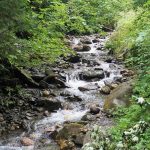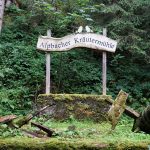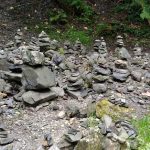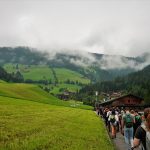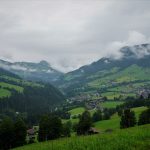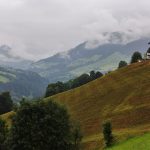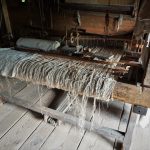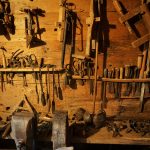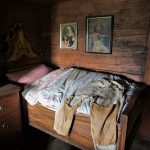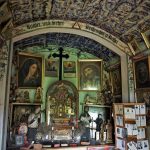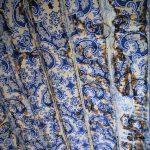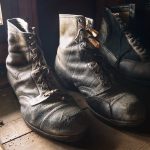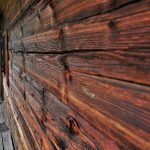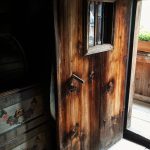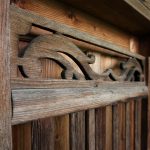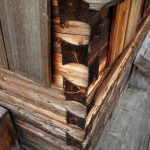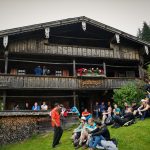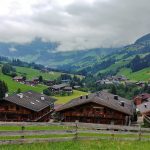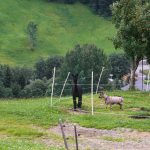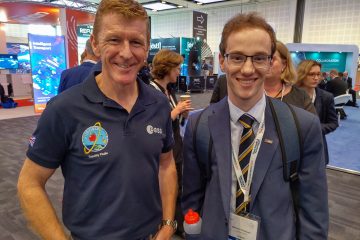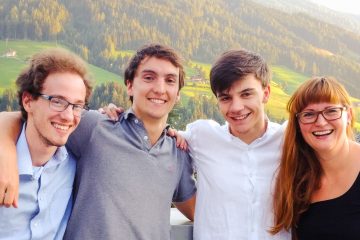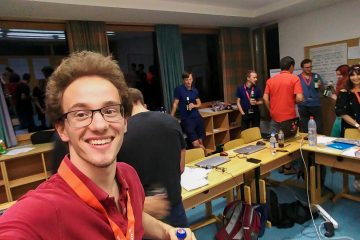After yesterday’s hectic preparation for the first review of our mission, this morning was a great opportunity to relax, with almost the entire Summer School cohort going on a hike around the local mountains, guided by our photographer, Michel. Leaving our rendezvous point at the Hotel Böglerhof at 9am, we headed up into the hills. Clouds surrounding the peaks meant we weren’t going to take the high route we had hoped, but we were still looking forward to what would prove to be a stunning hike.
As we set off, we started the ascent through a forest, walking alongside a very clear stream that was bouncing over the rocks. We passed the remains of a herb mill and the so-called Alpbach Stone Men, a community art project conceived by the local secondary school to symbolise team spirit, joy and creativity. The group of about 60 of us was taking lots of pictures, but we knew that many more photo opportunities were to come.
- A stream babbles through the forest during our morning hike.
- A sign depicting the location of the “Alpbach Herb Mill” on our hike through the forest.
- The Alpbach Stone Men stand in the forest at the beginning of our hike.
After the climb through the forest, we entered a flatter, more open area, where as the number of buildings decreased we could get a great sense of the size of the mountains and amount of open countryside that Austria has to offer.
The clouds were hugging the mountains as we continued our ascent, with the buildings scattered across their sides. Our route took us along a road that wound its way around the valley, giving us some spectacular views along it.
By this point in the hike, what had started off as slight drizzle when we left the Hotel Böglerhof had become more intense, forcing us to don our rain jackets. The rain offered some welcome refreshment though during the hard work of climbing steep hills between pauses for pictures.
The rain became heavier again as we descended into the forest. A more hot and humid environment would have made it feel quite like the rainforest of South America, as the droplets bounced between the leaves of the canopy and onto our heads while we crossed bridges over another stream.
Our route soon took us back to a road leading through Inneralpbach, giving us more opportunities to see the wooden architecture for which Austria is so well known. Eventually we started climbing again as we reached a fork in the valley, with the path leading us up to our hike’s final destination: the Bergbauernmuseum, or mountain farming museum. Passing a large hotel and an interesting church on the way, we reached the museum at about 10:45.
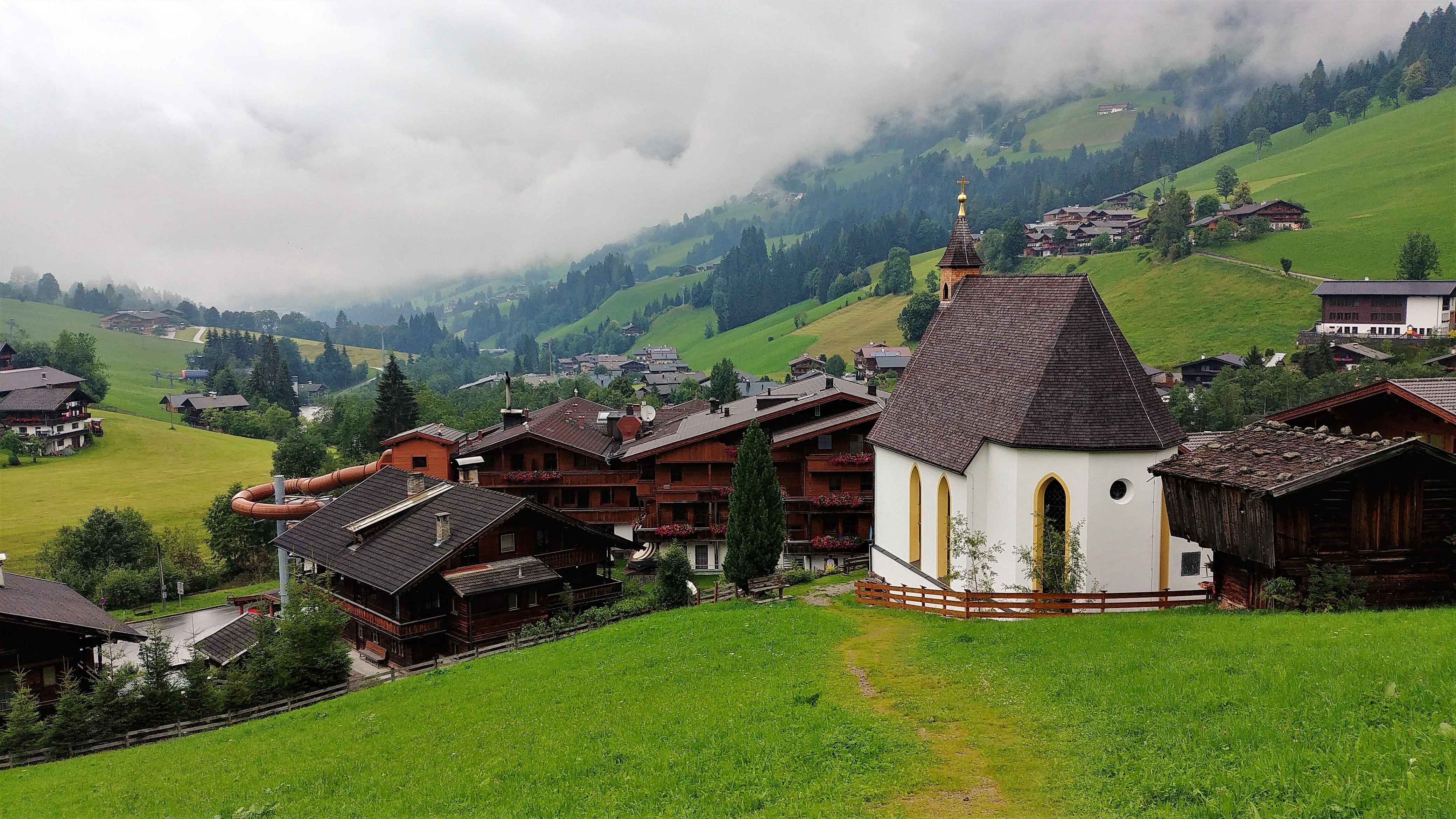
The museum is contained within a traditional Austrian farmhouse, built in the 1630s as a home for a family of farmers who worked the nearby land. When we arrived, the museum’s owner, from the same family that still owns the farmhouse and its adjacent modern equivalent, explained how the only room in the building that had been heated was the living room, despite the Alps’ harsh winters. He told us about the types of materials that would be made inside, like linen and flax. The family, he said, would extract the fibres from plants they grew themselves, then would bind them together to make the fabrics they needed for everyday life.
We discovered that the old farmhouse was lived in until the 1950s, when the family finally decided to build a new home next door. Walking round the old building, it was amazing to think that a family could have lived in such a traditional way into the middle of the last century. All around were relics of processes and ways of life that in the modern age seemed archaic, like the loom that bound the fibres of their fabrics. or the hand tools that they used to craft wood.
As we walked round the old wooden farmhouse, being careful not to bump our heads on any of the low doorways, it was also clear that Catholicism was a very important part of the family’s life. Religious paintings adorned the walls of any room in which they would have rested or slept, with the clearest sign of their faith being the chapel in the corner of the building. This would have acted as the family’s place of worship for many years before the churches in the valley were made accessible by the building of roads.
Seeing the chapel for the first time, I couldn’t help a small gasp. The room was rich in colour, with paintings covering all the walls and a collection of statues arranged carefully on the small altar at the front of the room. There were even small pews, but the most amazing feature was the ceiling, painted in bright intricate patterns of blue. Clearly the family had, over the years, spent a great deal of time and effort perfecting their chapel, demonstrating their dedication to their faith.
Another intriguing aspect of the centuries-old farmhouse was its wooden construction. Although the age of the beams and planks had led them to bow in places, every piece fitted together perfectly. The rich, knotted wood had a colour and texture that reminded me of the fires that occasionally sweep through Austria’s forests, causing me to think how vulnerable this all-wooden building would be in such an event.
The grain of the wood had also been used to great effect, leading the eye along the planks in a way that only such a natural material really can. The earthy theme was visible throughout the building, particularly in the family’s tools and clothes. Their boots, which stood on a windowsill waiting to be used, looked like they could have just been taken off after a long day working the fields, with their strongly textured leather reminding me of how connected the family would have been to nature.
We rested for a few minutes at the farmhouse and took the opportunity to eat our lunches, but before long it was time to return along the valley to Alpbach. The views were again amazing and as we tiredly hiked back to the village a friendly alpaca was a fun distraction, causing many of our group to line the path to take pictures.
Eventually, we arrived back in Alpbach, many of us heading straight to our guest houses for some well-earned rest after the long hike.
A while later, after the relaxing morning, it was time to get back to work on our missions. We had a meeting to remind everyone on the team what stage of development the various aspects of the mission were at, before we again split off into our sub-groups to continue working on our tasks.
I helped to choose the method through which our sample would be returned to orbit around the asteroid from the surface. From a selection of six concepts we applied logic, common sense about the practicality of each method, and the experience of our tutors. We selected a concept where the sample will be fired by a spring or moving platform from a lander on the surface up towards the orbiter, which will use its thrusters to hover directly overhead and enable the capture of the canister.
This idea will provide a good trade-off between system complexity and redundancy in our mission, because even in the event of the sample canister retrieval failing, good science data can still be collected by the orbiter and the lander, ensuring a wide range of measurements.
Finally though, after a long, tiring day, it was time to head to bed. Tomorrow we will continue working towards Monday’s Preliminary Design Review (PDR), further developing and refining our mission’s systems.
Don’t forget you can find all my tweets about my Alpbach experience under #AlpbachSummerSchool and I’ll continue posting on this blog throughout the trip.
